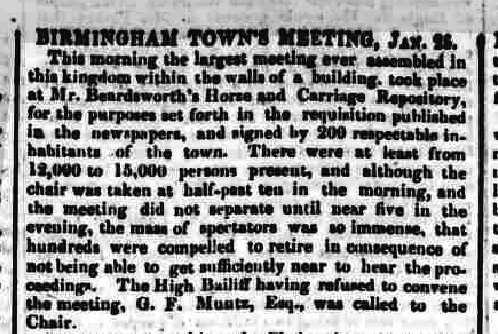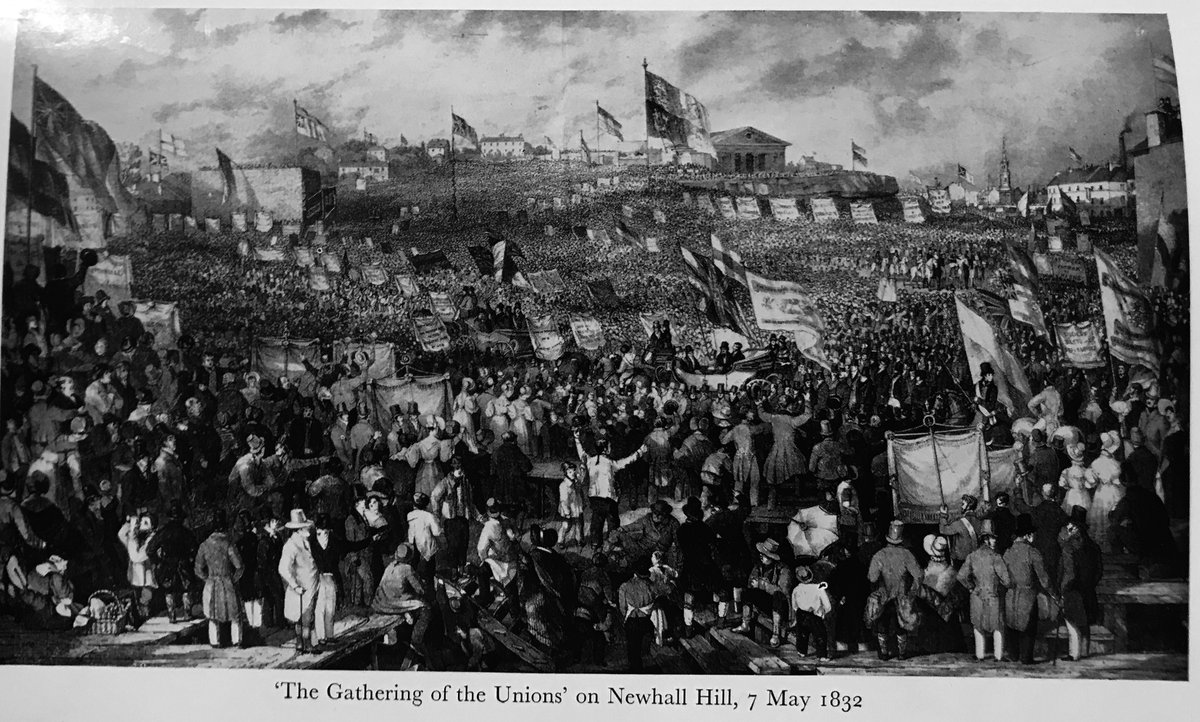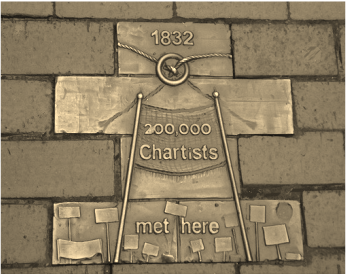#heritageofprotest
I have been doing some work on sites of protest in Birmingham and have come up with no less than 18 meetings over 21 years from 1817-1838. Eleven of these were at Newhall Hill a former sandstone quarry on the Colemore Estate which left a perfect amphitheatre
I have been doing some work on sites of protest in Birmingham and have come up with no less than 18 meetings over 21 years from 1817-1838. Eleven of these were at Newhall Hill a former sandstone quarry on the Colemore Estate which left a perfect amphitheatre
#heritageofprotest
… ideal for open air meetings was bisected by ‘Miss Caroline’s Canal’, a private branch of the Birmingham & Fazeley navigation commissioned in 1809 by Caroline Colmore to transport sandstone
… ideal for open air meetings was bisected by ‘Miss Caroline’s Canal’, a private branch of the Birmingham & Fazeley navigation commissioned in 1809 by Caroline Colmore to transport sandstone
#heritageofprotest
The Newhall Hill site is now heavily developed but for a brief period in 2001 photographer Bob Miles gained access to the exposed cliff face which helps us visualize the amphitheater as it may have looked in the early nineteenth century
The Newhall Hill site is now heavily developed but for a brief period in 2001 photographer Bob Miles gained access to the exposed cliff face which helps us visualize the amphitheater as it may have looked in the early nineteenth century
#heritageofprotest
At an early meeting in 1818 this report honours the police for protecting the orderly meeting from ‘vagabond mountebanks’ disrupting proceedings
At an early meeting in 1818 this report honours the police for protecting the orderly meeting from ‘vagabond mountebanks’ disrupting proceedings
#heritageofprotest
The site became contentious the following year when schoolmaster, George Edmonds staged a mock election to return an MP for the town, despite Birmingham not being represented. Edmonds and 4 others were imprisoned for this act of temerity
The site became contentious the following year when schoolmaster, George Edmonds staged a mock election to return an MP for the town, despite Birmingham not being represented. Edmonds and 4 others were imprisoned for this act of temerity
#heritageofprotest
A further meeting was held in September that year in solidarity with the victims of Peterloo
Meetings were also held at the large indoor venue of Beardsworth’s Repository which held a staggering 12,000 people
A further meeting was held in September that year in solidarity with the victims of Peterloo
Meetings were also held at the large indoor venue of Beardsworth’s Repository which held a staggering 12,000 people
#heritageofprotest
After the wave of post-Peterloo meetings there was a relative lull in reform meetings during the 1820s but activity increased during the reform crisis of the early 1830s with six meetings recorded in the years 1830-1833. Banker, Thomas Attwood launched the …
After the wave of post-Peterloo meetings there was a relative lull in reform meetings during the 1820s but activity increased during the reform crisis of the early 1830s with six meetings recorded in the years 1830-1833. Banker, Thomas Attwood launched the …
Birmingham Political Union at Newhall Hill on 25 Jan 1830. The BPU held a monster rally to petition the Lords to pass the 2nd reading of the Reform Bill. Record attendance of 150,000 was cklaimed for the mtg on Oct 3 1831 but the figure was probably closer to 15,000.
#heritageofprotest
This extract from Lord Russell’s speech to the House of Commons bemoaning the refusal of the Lords to pass the Reform Bill the previous Friday indicates his belief in the power of the crowd
This extract from Lord Russell’s speech to the House of Commons bemoaning the refusal of the Lords to pass the Reform Bill the previous Friday indicates his belief in the power of the crowd
#heritageofprotest
3 meetings were held during the 1832 constitutional crisis triggered by the refusal of the Lords to ratify the Reform Bill passed earlier in the commons.
3 meetings were held during the 1832 constitutional crisis triggered by the refusal of the Lords to ratify the Reform Bill passed earlier in the commons.
Next year, the ‘Days of May’ were notable for the fact that, rather than opposing the government, these protests were orchestrated in support government, against the Bishops, Lords and Duke of Wellington. These meeting are encapsulated in sketches, prints and paintings
#heritageofprotest
The BPU continued to hold meetings at Newhall Hill support of the Irish Reform Bill, against the Corn-laws, and in solidarity with ‘The wretched condition of Poland’
The BPU continued to hold meetings at Newhall Hill support of the Irish Reform Bill, against the Corn-laws, and in solidarity with ‘The wretched condition of Poland’
#heritageofprotest
When Attwood launched the Birmingham Chartist movement in 1838, the venue was moved 1 mile south to the larger Holloway Head site. The ‘Grand Midland Demonstration’ was one of the first times the word ‘demonstration’ was used to describe a political protest
When Attwood launched the Birmingham Chartist movement in 1838, the venue was moved 1 mile south to the larger Holloway Head site. The ‘Grand Midland Demonstration’ was one of the first times the word ‘demonstration’ was used to describe a political protest
#heritageofprotest
There is little to commemorate the significance of Newhall Hill as a site of protest heritage apart from an inaccurate plaque stating that 200,000 Chartist met in 1832 - the word Chartist didn’t appear till 6 years later but that is just splitting hairs . . .
There is little to commemorate the significance of Newhall Hill as a site of protest heritage apart from an inaccurate plaque stating that 200,000 Chartist met in 1832 - the word Chartist didn’t appear till 6 years later but that is just splitting hairs . . .

 Read on Twitter
Read on Twitter
















